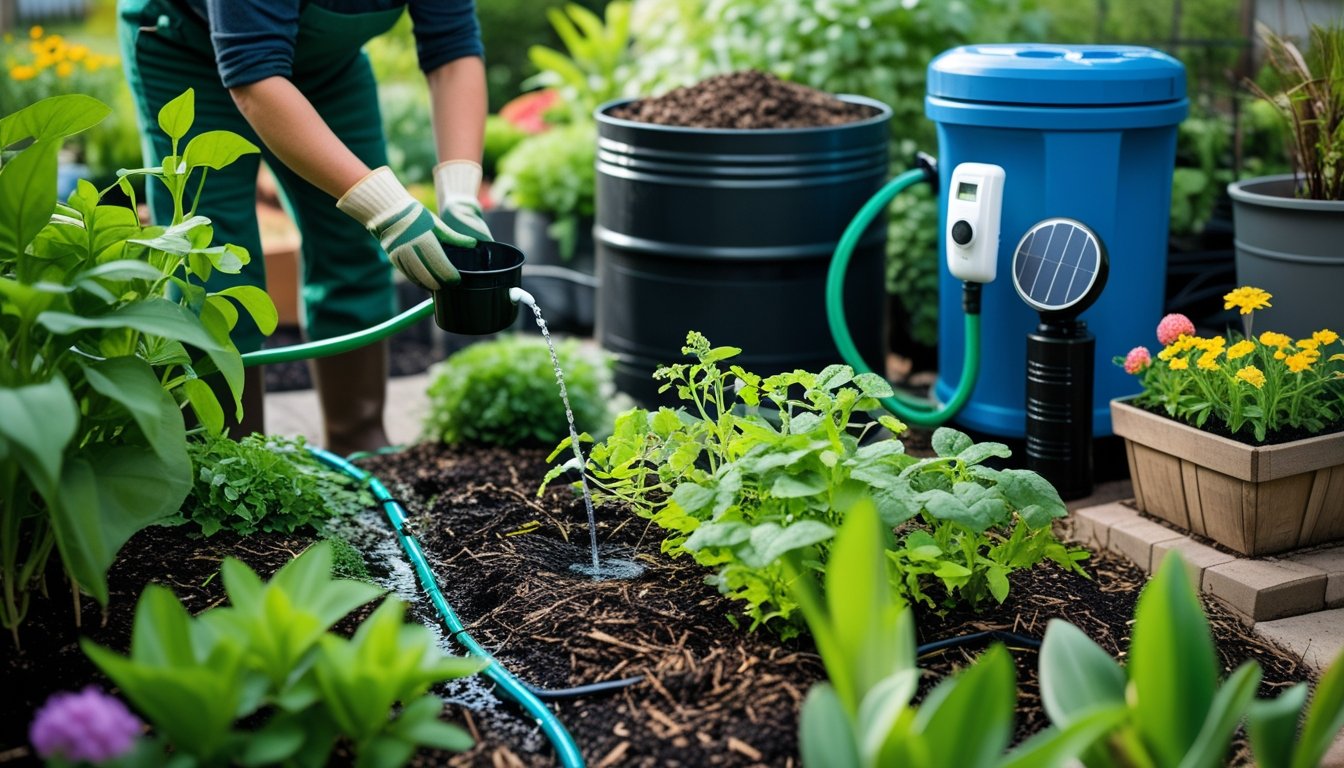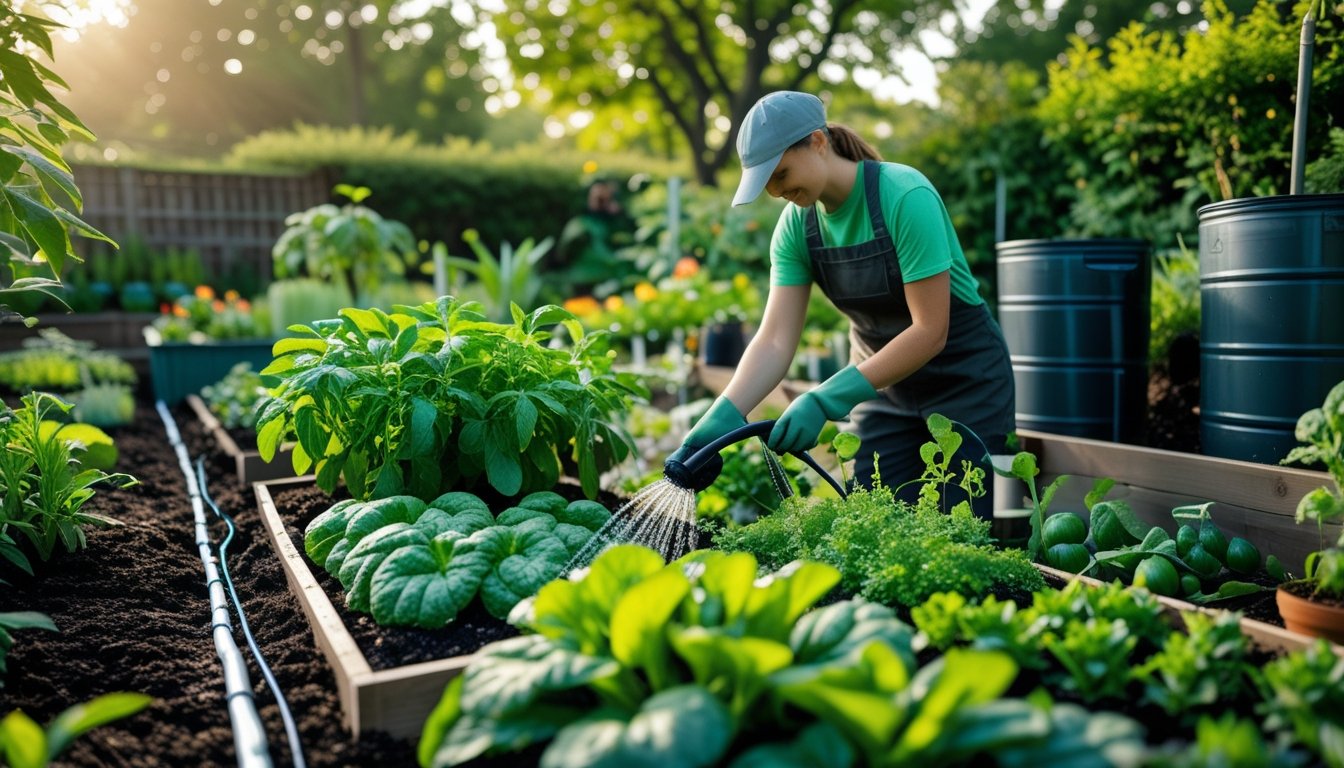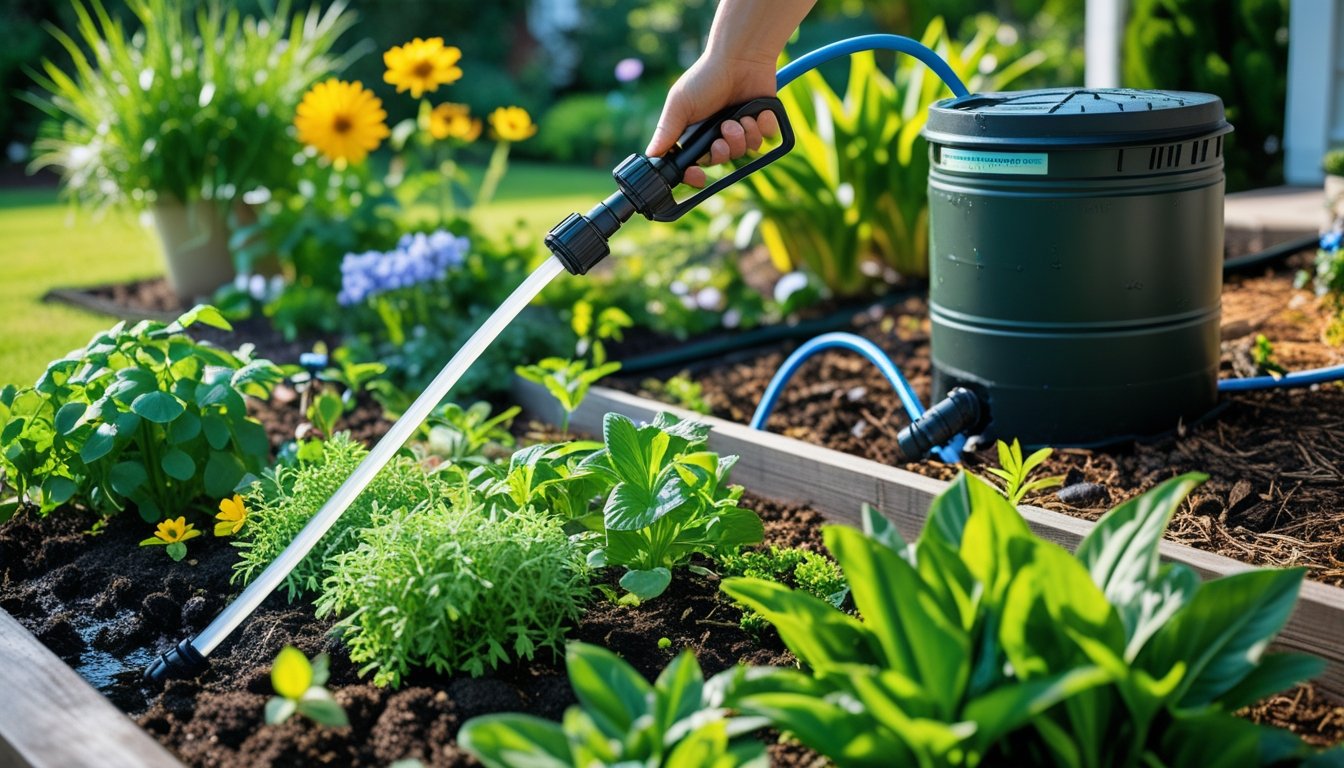Late updated: 25 Oct 2025 08:10
Written by: Sarah Hollister
Eco-Friendly Tips For Reducing Garden Water Usage: Practical Strategies For Conservation
Creating an eco-friendly garden that thrives while conserving water is not just environmentally responsible, it’s also practical and rewarding. By implementing strategies like utilising drought-resistant plants, employing drip irrigation, and harnessing rainwater, we can significantly reduce water usage in our gardens. These methods not only support the health of our plants but also lower water bills and reduce our environmental footprint.

Water conservation techniques are becoming essential as we face drier conditions and water scarcity. Our approach to gardening must adapt to these changes by adopting practices that minimise waste and maximise the efficiency of water resources. This way, we ensure that our gardens remain lush and vibrant without compromising on sustainability.
Understanding sustainable gardening is about finding the balance between the needs of our plants and the availability of natural resources. Our focus is on simple, actionable tips that guide gardeners of all levels towards creating resilient outdoor environments.
Key Takeaways
- Utilise water-efficient techniques like drip irrigation and rainwater harvesting.
- Prioritise drought-resistant plants for reduced water dependency.
- Adopt sustainable practices to maintain healthy soil and plant growth.
Core Eco-Friendly Strategies for Reducing Garden Water Usage
By implementing targeted strategies, we can significantly reduce the water consumption in our gardens. The key is to focus on optimising irrigation techniques, using suitable plants, and harvesting rainwater effectively.
Optimising Irrigation Systems
Efficient irrigation is central to conserving water. Drip irrigation systems are an ideal choice, as they deliver water directly to the plant roots, reducing evaporation. These systems can decrease water usage by up to 60% compared to traditional sprinklers.
Soaker hoses are another excellent option, providing deep watering that encourages strong root growth. For those looking for high-tech solutions, smart irrigation systems offer remarkable control.
These systems can be adjusted based on weather conditions, ensuring plants receive optimal hydration without waste. Incorporating these systems into our gardens allows us to maintain plant health while significantly curbing water usage.
Mulching Techniques for Moisture Retention
Mulching is an effective method to retain soil moisture and protect plants from extreme temperatures. By applying organic mulch like straw, wood chips, or bark, we can create a protective layer.
This layer helps retain moisture by slowing down evaporation, reducing the need for frequent watering. Mulch also suppresses weeds, which can compete with plants for water.
In addition to retaining moisture, mulching improves soil structure as the organic material breaks down. This process enhances water infiltration and retention. Regular maintenance, such as replenishing mulch as it decomposes, is necessary to ensure ongoing benefits.
Utilising Native and Drought-Tolerant Plants
Selecting the right plants is vital for creating an eco-friendly garden. Native plants are naturally adapted to local conditions, making them more resilient and less reliant on additional watering. These plants often thrive with only rainfall.
Drought-tolerant plants are another excellent choice, featuring deep root systems that seek out water from deeper soil layers. Some popular drought-tolerant options include lavender, sage, and succulents.
Using these types of plants reduces the overall water demand. Additionally, they require less fertiliser and pesticide use, promoting a healthier and more sustainable garden ecosystem.
Harvesting and Reusing Rainwater
Rainwater harvesting is a traditional yet highly effective method for water conservation. Setting up rain barrels to collect runoff from roofs allows us to store and reuse water for garden irrigation.
A rain barrel system is simple to install and can significantly reduce reliance on mains water. Besides reducing water bills, using harvested rainwater provides plants with chemical-free hydration.
By coupling this method with efficient irrigation systems, we can maximise water usage efficiency. Collecting and reusing rainwater not only supports a sustainable gardening practice but also lessens the burden on local water resources during periods of scarcity.
Sustainable Gardening Practices to Maintain Soil and Plant Health

Maintaining soil and plant health is critical to sustainable gardening. Practices such as enhancing soil structure, reducing lawn areas, and optimising watering techniques are essential for a thriving and eco-friendly garden.
Enhancing Soil Structure and Fertility
Improving soil structure and fertility starts with understanding its composition. We can begin by incorporating organic matter like compost, which enriches the soil with nutrients and improves its texture. This makes it more conducive for plants to establish strong root systems.
Using cover crops, such as clover, helps protect the soil from erosion and suppresses weed growth while naturally adding nitrogen back into the soil. Implementing crop rotation is another effective method. It prevents nutrient depletion by alternating plant families each year, which also breaks pest and disease cycles.
Mulching plays a vital role in soil health. By applying a layer of organic mulch, we can conserve moisture, regulate soil temperature and add essential nutrients back into the soil as it decomposes. This simple practice brings significant benefits to the garden.
Reducing Lawn Areas and Encouraging Eco-Friendly Designs
Traditional lawns often demand substantial water and maintenance. Reducing lawn areas can lead to more sustainable landscapes. By replacing portions of lawns with native plants, we can create xeriscapes that require less water and upkeep.
Proceeding with design alternatives such as rock gardens or using permeable paving solutions promotes effective water usage. These strategies reduce runoff and help soil retain moisture. Incorporating wildflower patches attracts local pollinators and aids in restoring biodiversity to our gardens.
Vertical gardening can also be a productive use of limited spaces, enriching the ecosystem and providing habitats for various species. With thoughtful planning, we can create gardens that are both visually appealing and eco-conscious, supporting the environment and reducing our carbon footprint.
Timing and Techniques for Efficient Watering
Proper watering techniques are essential for maintaining plant health without wasting water. It's crucial to water gardens early in the morning or late in the afternoon to minimise evaporation. This ensures that water reaches the roots effectively.
Employing drip irrigation systems can significantly reduce water usage while maintaining optimal moisture levels for plants. These systems deliver water directly to the root zones, reducing wastage and promoting healthier growth.
It's also important to group plants with similar water needs together. This allows us to tailor watering schedules accordingly, preventing over-watering of plants that require less moisture. By adopting such practices, we can make watering both efficient and eco-friendly, supporting sustainable gardening and reducing the impact of climate change.
Frequently Asked Questions

In our exploration of eco-friendly gardening, rainwater harvesting, mulching, and drought-resistant plants offer effective ways to reduce water usage. Drip irrigation, efficient watering techniques, and soil amendments support these strategies by enhancing water conservation and plant health.
What are the best methods for collecting and utilising rainwater in gardens?
Collecting rainwater can be achieved through rain barrels, which store water from roof runoffs for later use. Implementing a rain garden, which channels runoff to water-loving plants, is another effective method. Both options help reduce reliance on mains water use, providing gardens with a sustainable water source.
How can mulching help conserve water in garden landscapes?
Mulching insulates the soil, reducing evaporation and keeping the ground moist for longer periods. It also suppresses weed growth, reducing competition for available moisture. We find that using organic materials like straw, wood chips, or grass clippings not only conserves water but also enriches the soil as they decompose.
What drought-resistant plants are recommended for water-efficient gardening?
Lavender, succulents, and native grasses are excellent choices for water-efficient gardens. These plants thrive in low-water conditions and require minimal irrigation once established. By incorporating a variety of drought-tolerant species, we can maintain vibrant gardens that use less water and adapt to changing climate conditions.
Can you explain the benefits of drip irrigation compared to traditional sprinkler systems?
Drip irrigation delivers water directly to the plant's root zone, minimising evaporation and runoff. It ensures that water is used efficiently, reducing waste common with sprinkler systems. By targeting specific areas, we can tailor irrigation schedules to the precise needs of our plants, promoting healthier growth.
What are effective watering techniques to maximise efficiency and minimise waste?
Watering early in the morning or late in the afternoon reduces evaporation caused by the sun's heat. Using a soaker hose can provide even water distribution directly to the plant's base. We recommend checking soil moisture regularly to adjust watering schedules, ensuring plants receive adequate hydration without excess.
How does soil amendment contribute to reducing the need for watering in gardens?
Improving soil with organic materials like compost enhances its water retention capacity. Amendments add structure and nutrients, allowing the soil to hold water more effectively. By enriching soil this way, we can decrease reliance on frequent watering, supporting sustainable garden maintenance with reduced resource use.
